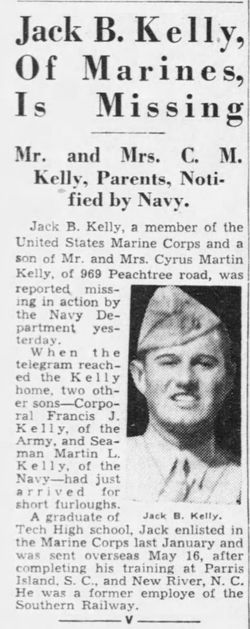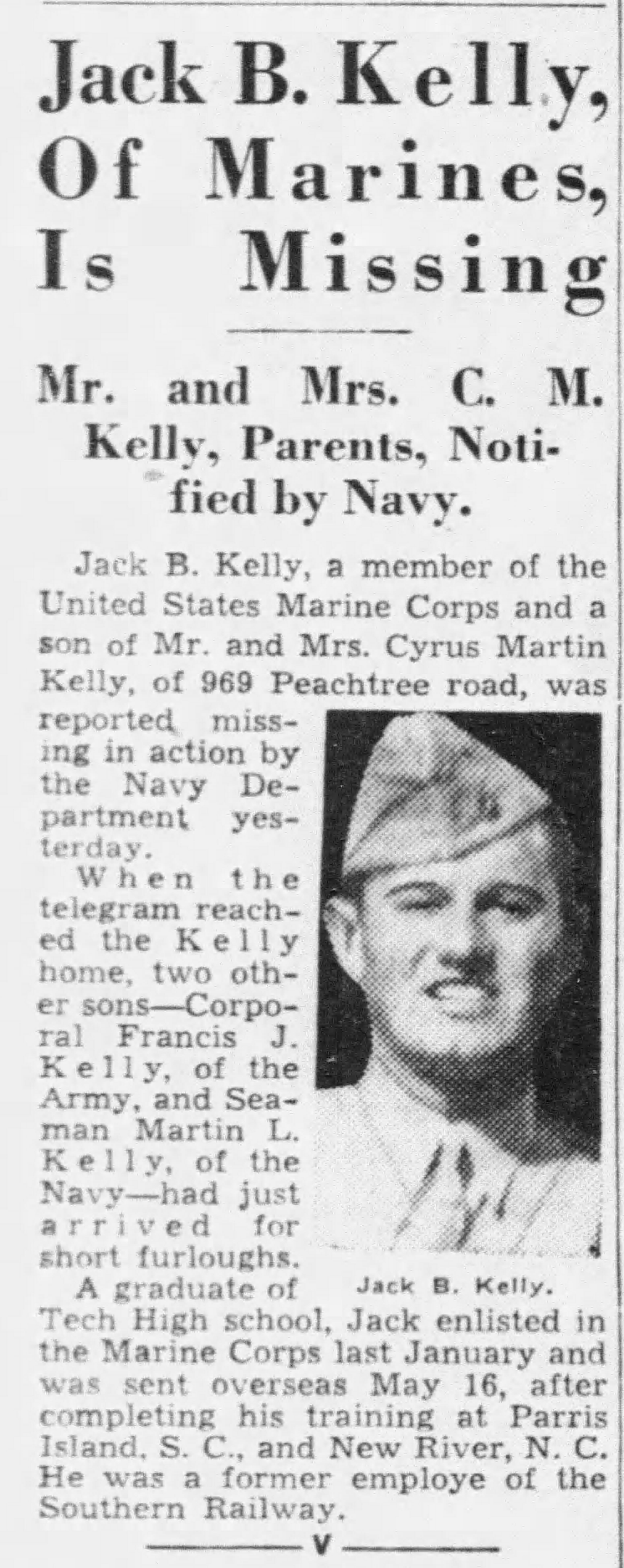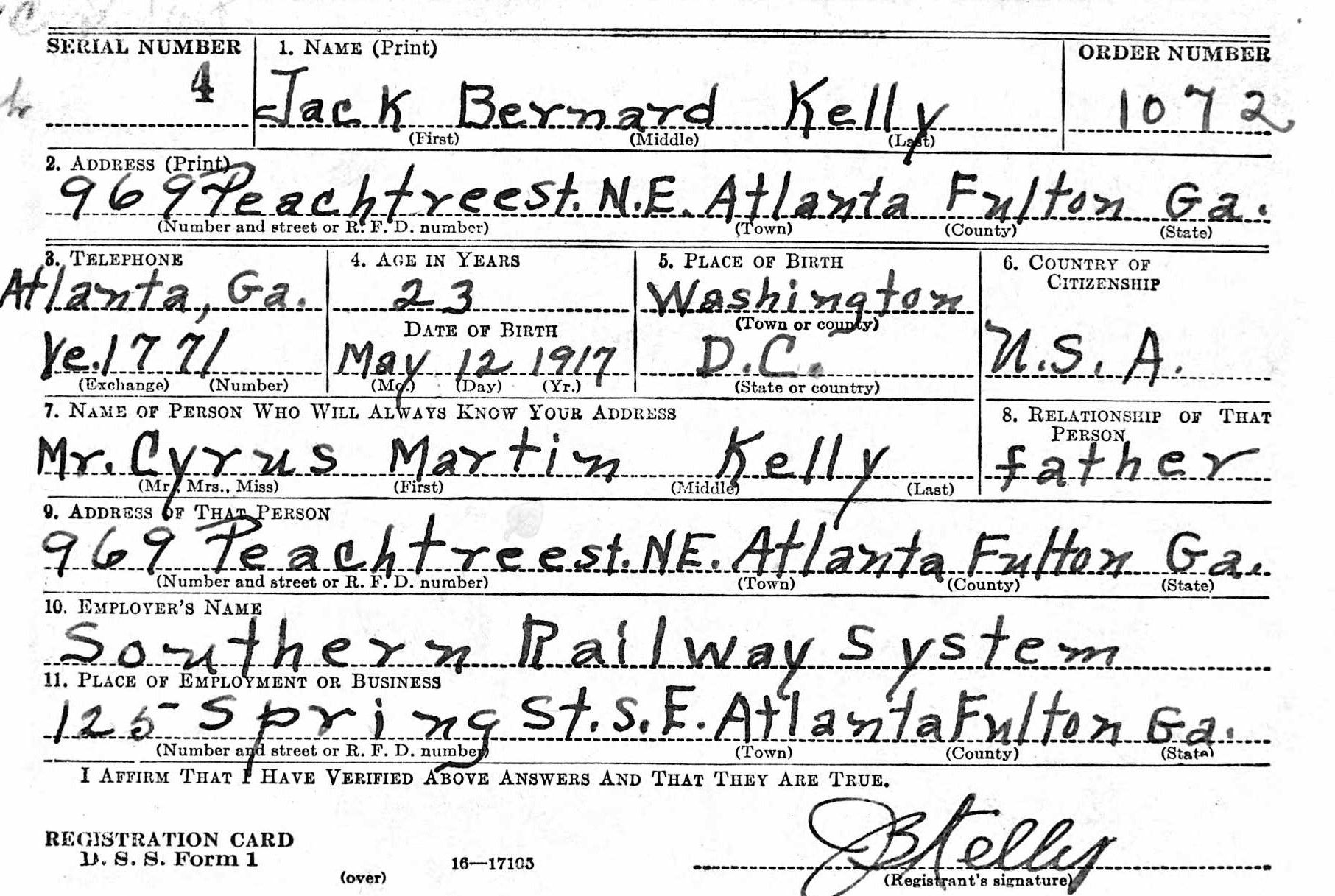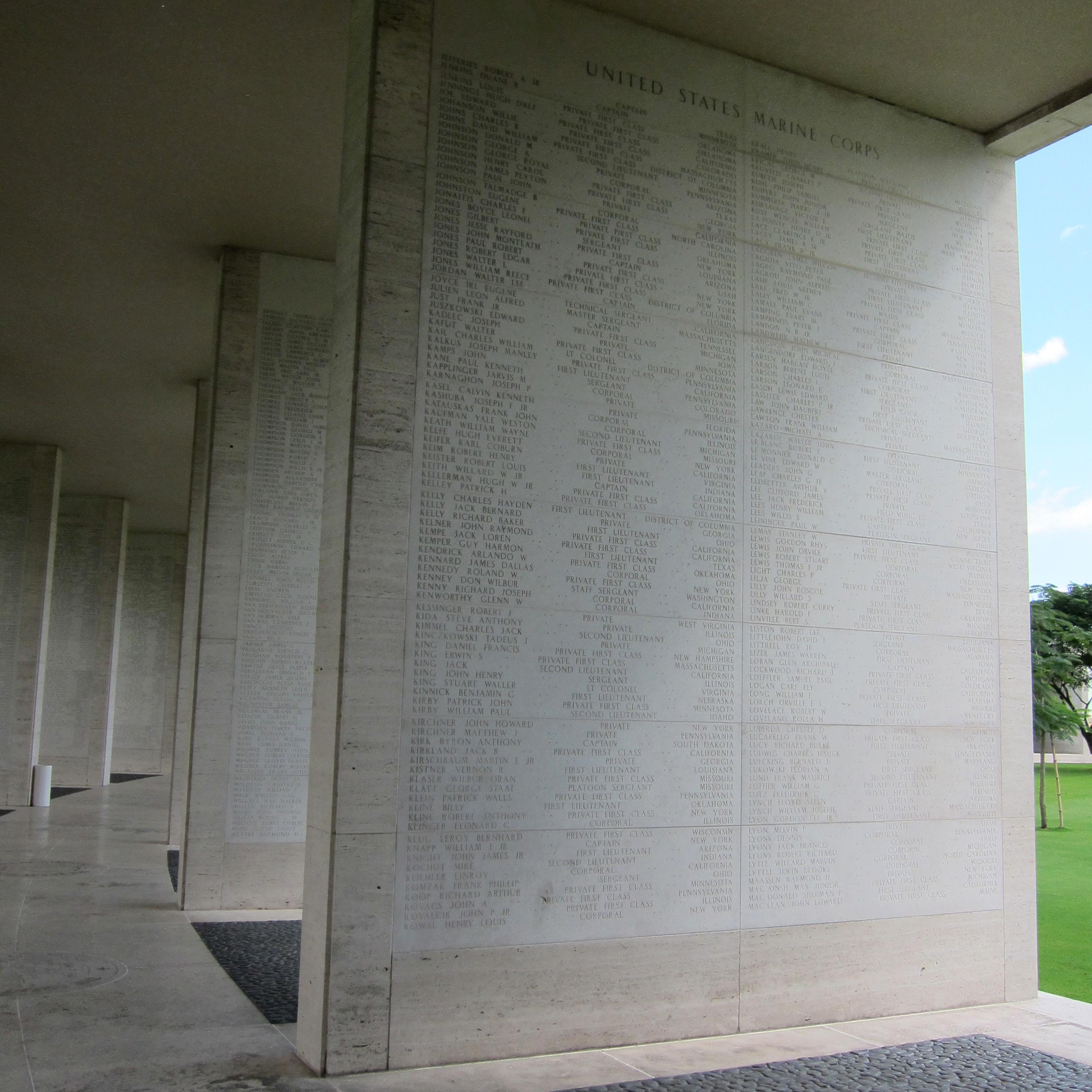The 1930 U.S. Census shows the family as living in Atlanta, Fulton County, Georgia. The following family members are listed as living in the home:
Head Cyrus M Kelly M 44 Minnesota
Wife Rose A Kelly F 44 Rhode Island
Dau Dolores K Kelly F 16 Washington D C
Son Jack Kelly M 12 Washington D C
Son Martin Kelly M 12 Washington D C
Son Francis Kelly M 10 Washington D C
Kelly enlisted on January 30, 1942 and attended boot camp at Parris Island. After graduation he was assigned to the First Marine Division deployed to New Zealand for further training. Throughout 1942, the primary objective of the First Marine Division was to take the fight to the Japanese. So shortly after their arrival at Wellington, the word was passed that they would soon be departing for the war zone. The Intelligence Section was concentrating on a small island in the Solomon Islands named Guadalcanal - it was chosen as their first target.
The landing on Guadalcanal went unopposed. The Japanese waited in the jungle for the coming battle with the Marines. The Intelligence Section set about gathering and analyzing information they gleaned from the area. On August 12th, a Marine patrol from the 3rd Battalion, 5th Marine Regiment, captured a Japanese soldier named Sakado, found in their area. The Marines learned that the Japanese west of the Matanikau River were a disorganized and demoralized group, short on food and in poor health. They could, Sakado thought, be induced to surrender given the proper conditions.
The commander of the Intelligence Section, Colonel Frank Bryan Goettge, had been annoyed by the rush job that intelligence had been forced into in New Zealand and the now apparent shortcomings in maps and other data were becoming more evident. Sakado was a godsend. Col. Goettge sent First Sergeant Steven Custer to organize a patrol, which Goettge himself would head. They would take an interpreter, a doctor, a good portion of the intelligence section and some riflemen for support, and boat across to a secluded beach where a white flag had reportedly been seen. They would convince the Japanese there to surrender and work their way back to Headquarters the next day, with Goettge presumably at the head of a cluster of happily surrendered Japanese.
The patrol, consisting of 25 men plus Sakado (who was led by a rope around his neck by Platoon Sergeant Denzil Ray Caltrider) out from the camp at Kukum at about 1800 hours – a twelve hour delay caused by numerous personnel changes. The men were traveling light, carrying enough food for one day, a canteen, a poncho, and only light weapons.
Due to tidal issues, the delay caused another problem – it was now too late to risk heading for the original landing site. Ignoring the warnings of Lieutenant Colonel Bill Whaling and the cries of Sakado, who begged them not to land there, the boat turned for shore and landed about 200 yards west of the Matanikau. The boat ran up on a sandbar, forcing the Marines to jump over the gun-whales and rock it free, creating quite a racket. They waded in to shore and, taking cover behind a line of banyan trees, held a quick council of war. All the noise they had made and now this pause gave the Japanese soldiers of the 2nd Platoon, 11th CU Security Force under Lt. Soichi Shindo, plenty of time to pick their targets. As Col. Goettge led an advance party into the treeline, two shots rang out. Col. Goettge fell dead with a shot to the head. The seriously wounded 1stSgt Custer dropped beside him. Two Marines who crawled forward to check on the men recovered Goettge's insignia and wristwatch. Command passed to Captain Wilfred Ringer. As more Marines dropped, killed or wounded, Cpt. Ringer called sent one of the men to get help from the base camp (he was killed a few hundred yards away). The remaining Marines formed a defensive perimeter on the beach, and over the course of the night and following morning were gradually picked off by the Japanese defenders. By dawn, the patrol had been wiped out aside from three survivors who managed to swim back to friendly lines one at a time. They reported seeing Japanese swords "flashing in the sun" as they fell upon the wounded and dead.
The bodies of the Goettge Patrol were never recovered. There were accounts of knowing where they were and that they had been thrown into fighting trenches and covered up. There were at least three reports over the following weeks after the fight that the bodies were partially buried in the sand with limbs sticking out of the makeshift graves. One report, made by a Marine years later stated he was on patrol at the scene of the slaughter and personally saw the mutilated bodies of Goettge's patrol to include decapitated torsos and boots with limbs still attached. But no bodies were ever recovered.
Several attempts over the past 65 years to locate the burial site of the Goettge Patrol have found nothing. It is suspected now that building in the general area and the change of the shoreline has resulted in the patrol's remains never being recovered. To this day, Kelly lies with his fellow Marines in a grave lost to time.
Private Jack Bernard Kelly, Sn# 361752, earned the following badges/decorations as a member of the United States Marine Corps during World War II:
- Combat Action Ribbon
- Purple Heart Medal
- Asiatic-Pacific Theater of Operations campaign Medal with one bronze battle/campaign star
- World War II Victory Medal
- Navy/Marine Corps Presidential Unit Citation Ribbon
- Marine Corps Rifle marksmanship badge
- Marine Corps Basic Qualification Badge with Bars
**NOTE** - A large portion of this bio is based on information from the website missingmarines.com. They have done a fantastic job of researching approximately 3000 US Marines whose bodies were lost in the war. This writer wholeheartedly recommends their site for researchers or families of the missing. - Rick Lawrence, MSgt., USMC/USAFR {RET})
The 1930 U.S. Census shows the family as living in Atlanta, Fulton County, Georgia. The following family members are listed as living in the home:
Head Cyrus M Kelly M 44 Minnesota
Wife Rose A Kelly F 44 Rhode Island
Dau Dolores K Kelly F 16 Washington D C
Son Jack Kelly M 12 Washington D C
Son Martin Kelly M 12 Washington D C
Son Francis Kelly M 10 Washington D C
Kelly enlisted on January 30, 1942 and attended boot camp at Parris Island. After graduation he was assigned to the First Marine Division deployed to New Zealand for further training. Throughout 1942, the primary objective of the First Marine Division was to take the fight to the Japanese. So shortly after their arrival at Wellington, the word was passed that they would soon be departing for the war zone. The Intelligence Section was concentrating on a small island in the Solomon Islands named Guadalcanal - it was chosen as their first target.
The landing on Guadalcanal went unopposed. The Japanese waited in the jungle for the coming battle with the Marines. The Intelligence Section set about gathering and analyzing information they gleaned from the area. On August 12th, a Marine patrol from the 3rd Battalion, 5th Marine Regiment, captured a Japanese soldier named Sakado, found in their area. The Marines learned that the Japanese west of the Matanikau River were a disorganized and demoralized group, short on food and in poor health. They could, Sakado thought, be induced to surrender given the proper conditions.
The commander of the Intelligence Section, Colonel Frank Bryan Goettge, had been annoyed by the rush job that intelligence had been forced into in New Zealand and the now apparent shortcomings in maps and other data were becoming more evident. Sakado was a godsend. Col. Goettge sent First Sergeant Steven Custer to organize a patrol, which Goettge himself would head. They would take an interpreter, a doctor, a good portion of the intelligence section and some riflemen for support, and boat across to a secluded beach where a white flag had reportedly been seen. They would convince the Japanese there to surrender and work their way back to Headquarters the next day, with Goettge presumably at the head of a cluster of happily surrendered Japanese.
The patrol, consisting of 25 men plus Sakado (who was led by a rope around his neck by Platoon Sergeant Denzil Ray Caltrider) out from the camp at Kukum at about 1800 hours – a twelve hour delay caused by numerous personnel changes. The men were traveling light, carrying enough food for one day, a canteen, a poncho, and only light weapons.
Due to tidal issues, the delay caused another problem – it was now too late to risk heading for the original landing site. Ignoring the warnings of Lieutenant Colonel Bill Whaling and the cries of Sakado, who begged them not to land there, the boat turned for shore and landed about 200 yards west of the Matanikau. The boat ran up on a sandbar, forcing the Marines to jump over the gun-whales and rock it free, creating quite a racket. They waded in to shore and, taking cover behind a line of banyan trees, held a quick council of war. All the noise they had made and now this pause gave the Japanese soldiers of the 2nd Platoon, 11th CU Security Force under Lt. Soichi Shindo, plenty of time to pick their targets. As Col. Goettge led an advance party into the treeline, two shots rang out. Col. Goettge fell dead with a shot to the head. The seriously wounded 1stSgt Custer dropped beside him. Two Marines who crawled forward to check on the men recovered Goettge's insignia and wristwatch. Command passed to Captain Wilfred Ringer. As more Marines dropped, killed or wounded, Cpt. Ringer called sent one of the men to get help from the base camp (he was killed a few hundred yards away). The remaining Marines formed a defensive perimeter on the beach, and over the course of the night and following morning were gradually picked off by the Japanese defenders. By dawn, the patrol had been wiped out aside from three survivors who managed to swim back to friendly lines one at a time. They reported seeing Japanese swords "flashing in the sun" as they fell upon the wounded and dead.
The bodies of the Goettge Patrol were never recovered. There were accounts of knowing where they were and that they had been thrown into fighting trenches and covered up. There were at least three reports over the following weeks after the fight that the bodies were partially buried in the sand with limbs sticking out of the makeshift graves. One report, made by a Marine years later stated he was on patrol at the scene of the slaughter and personally saw the mutilated bodies of Goettge's patrol to include decapitated torsos and boots with limbs still attached. But no bodies were ever recovered.
Several attempts over the past 65 years to locate the burial site of the Goettge Patrol have found nothing. It is suspected now that building in the general area and the change of the shoreline has resulted in the patrol's remains never being recovered. To this day, Kelly lies with his fellow Marines in a grave lost to time.
Private Jack Bernard Kelly, Sn# 361752, earned the following badges/decorations as a member of the United States Marine Corps during World War II:
- Combat Action Ribbon
- Purple Heart Medal
- Asiatic-Pacific Theater of Operations campaign Medal with one bronze battle/campaign star
- World War II Victory Medal
- Navy/Marine Corps Presidential Unit Citation Ribbon
- Marine Corps Rifle marksmanship badge
- Marine Corps Basic Qualification Badge with Bars
**NOTE** - A large portion of this bio is based on information from the website missingmarines.com. They have done a fantastic job of researching approximately 3000 US Marines whose bodies were lost in the war. This writer wholeheartedly recommends their site for researchers or families of the missing. - Rick Lawrence, MSgt., USMC/USAFR {RET})
Gravesite Details
Entered the service from Georgia.
Family Members
Sponsored by Ancestry
Advertisement
Explore more
Sponsored by Ancestry
Advertisement










